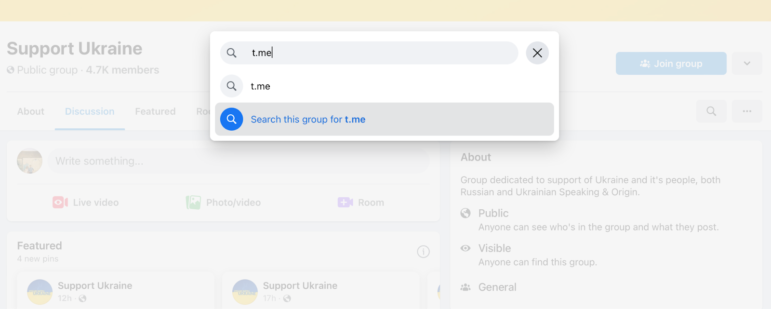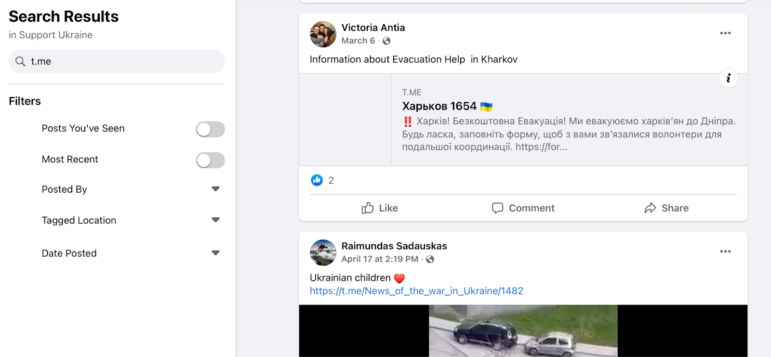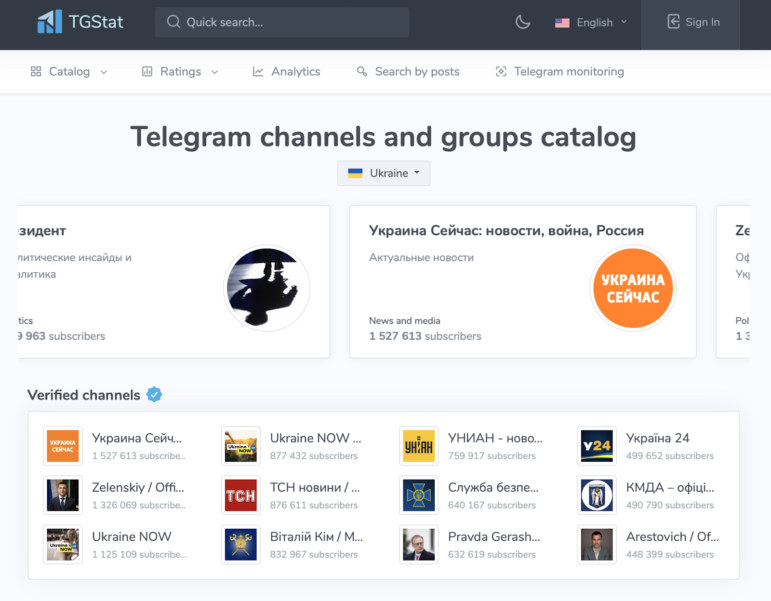
Image: Shutterstock
As one of the few social media platforms still available inside Russia and a key conduit for reporting from war-torn Ukraine, Telegram’s global profile has greatly increased in recent months. But even before that, the app had grown in popularity among those seeking anonymous communications free from government censorship, and among the neo-Nazis, Islamic State supporters, and drug traffickers who found fertile ground for their activities on the platform.
Despite — or because of — this somewhat dubious reputation, Telegram can also be an invaluable research tool, allowing journalists to mine information and investigate groups of people whose content is otherwise banned or limited on other social networks (often for violating terms of use or hate speech laws). It’s also useful to track protests and other social movements in authoritarian countries, like Russia, where the app still functions.
[Note: There is debate over how secure Telegram actually is. Telegram channels and group chats are not end-to-end encrypted and do not protect users’ identities. One-to-one chats are also not fully encrypted unless users turn on the “secret chat” function.]For this primer on Telegram, GIJN has relied heavily on Telegram 101 for Journalists, a recent webinar by The Shorenstein Center on Media, Politics and Public Policy at the Harvard Kennedy School. The event featured media disinformation expert Jane Lytvynenko, a research fellow at the Center, who discussed best practices in using Telegram for investigative reporting.
Telegram 101
Founded in 2013 by Pavel and Nikolai Durov, the two Russian brothers behind Facebook-lookalike VKontakte, Telegram boasted more than 550 million users worldwide as of January 2022. Its appeal: a reputation for privacy in communications and commerce.
Telegram also distinguishes itself from other social or messaging platforms with its vigorous privacy protection and free speech policies. This is evident on its FAQ page, where it states: “If criticizing the government is illegal in some country, Telegram won’t be a part of such politically motivated censorship.”
In keeping with this philosophy, the company says it does not share user data with governments unless compelled. “If Telegram receives a court order that confirms you’re a terror suspect, we may disclose your IP address and phone number to the relevant authorities,” the company’s privacy policy reads. “So far, this has never happened.” Others are more cautious. Telegram’s security model, warns the Electronic Frontier Foundation, “requires users to place a great deal of trust in Telegram’s ability to protect user data.” [Editor’s note: After the publication of this article, Der Spiegel published a story that found, contrary to Telegram’s claims, the company has shared private user data with German law enforcement in alleged terrorism and child sexual assault material cases. Neither Telegram or Durov responded to Der Spiegel’s requests for comment.]
In fact, the 37-year-old Pavel Durov, with an estimated net worth of $15 billion, has taken steps demonstrating his commitment to freedom from government intrusion. He fled Russia in 2014 after refusing to cooperate with demands from the Kremlin after that country’s annexation of Crimea. The German government’s attempts to fine Telegram over a lack of moderation for illegal content ran into a dead-end at an empty Telegram office in Dubai, United Arab Emirates.
Telegram has high adoption rates in several countries with poor track records for freedom of expression. It is the most popular messaging app in several former Soviet republics (Belarus, Kazakhstan, and Kyrgyzstan) as well as Venezuela, Jordan, and Cambodia, according to publicly available data from Similarweb, an analytics site. Telegram’s largest national audiences, per TGStat, a metrics site, are in Russia and Iran, followed by India and Uzbekistan.
The app has been used to communicate in war zones, protect journalists’ sources, and avoid hacking. This is thanks to several key aspects of the platform:
- End-to-end encryption of direct messaging, if users engage in a “secret chat.” This privacy capability is thanks to Telegram not relying on third-party software to backup or store user data. Nor does it store secret chats on its servers.
- Self-destruct mode, a key feature that allows users to set an expiration date for messages, which may be after a few seconds or a number of days. This is particularly useful if you are sharing sensitive information or at risk of having your phone confiscated.
- The ability to anonymize your profile by hiding your phone number from all users, including contacts on your phone. The app also allows you to have an empty username.
Using Telegram as an Investigative Tool
Archiving
Lytvynenko recommended downloading the desktop version from Telegram.org in order to use the archiving and download functions, which are not available on mobile. Unlike many other social media or messaging apps, Telegram makes it quite easy to save images, videos, and other material — including vital metadata — posted to the app. In fact, the desktop app allows you to download entire channels in HTML format. And all that documentary evidence, when properly archived, can be a gold mine for investigative reporters.
Group chats
Telegram’s public and semi-public group chats allow up to 200,000 users. “This is incredibly important because a lot of coordination, particularly on the ground in Ukraine right now, happens in these massive group chats,” said Lytvynenko. She recommended searching for these chats on other social media platforms to find sources.
Channels
Channels are one-way means of sharing content on Telegram and can be private or public. They are a great way to gather news and information from outlets, officials, and influential individuals. Some newsrooms have their own verified Telegram channels, identifiable with a blue checkmark.
Bots
To distinguish them from human users on Telegram, bots are clearly identified with usernames ending in “bot.” (For instance, @FBvidzBot will download any video from Facebook when you provide a hyperlink.) Anyone can create — and manage — Telegram bots using the BotFather tool. Telegram has its own in-house bots, too, which answer user requests and perform many other tasks. All bots, including yours, if you launch one, can be found in the Telegram directory: t.me/<bot_username>.
Tips for Searching on Telegram
“Global Search does not use advanced search functions like you would expect on Google or Twitter, so you really have to think through the key terms that might be useful to you,” Lytvynenko said of Telegram’s own search function. Instead, she advised using Google advanced search to discover channels, which can be done in Google search using the following formula:
“site: t.me/* (keyword1 OR keyword2)”
Example: site: t.me/* (Ukraine OR 🇺🇦)
“The asterisk means Google will fill in the username for us,” Lytvynenko explained. This formula will help you retrieve the top Telegram channels indexed by Google. “This will not get you group chats, and this will not get you niche channels, but it is a really good way to start your Telegram research, based on what you’re looking for.”

Searching for Telegram channels is often easier to do using a Google search, says Lytvynenko. Image: Screenshot
To search for channels shared on Twitter, Lytvynenko advised using Twitter’s search bar with this formula:
“t.me (keyword)”

Lytvynenko recommends using a similar search strategy when looking for Telegram channels via Twitter. Image: Screenshot
Both Google and Twitter respond to basic boolean searches, so you also can use the following, simpler search inputs:
keyword1 AND keyword2
keyword1 OR keyword2
But don’t just limit your searches to text. For example, when investigating Russia’s war on Ukraine, Lytvynenko advised searching for either country’s flag emoji (🇷🇺 and 🇺🇦), which is often used on social media.
Searching within Facebook Groups
“Particularly around Ukraine, and also with other revolutions and wars, we’ve seen Facebook groups become hubs for coordination, which means that they’re also hubs for Telegram channels,” Lytvynenko said, noting the habit of Facebook users who share ways to move their conversations to a more secure platform. Sifting through Facebook groups at the beginning of your investigation can help you identify Telegram channels or groups mentioned by the users you’re interested in.
Users may not be aware that their posts on groups are visible to non-members, so be mindful of exposing their identity if you share their posts.
- Look up Facebook groups related to your chosen topic.
- Search within a Facebook group for “t.me” to find Telegram channels shared on the group.

The same “t.me” search term can be used to find Telegram channels mentioned in Facebook groups. Image: Screenshot
- Use the filters function to sort or search posts by date, location, and more.

Investigators can use Facebook group filters to search for Telegram posts by date, location, and more. Image: Screenshot
TGStat
TGStat won’t help you identify a channel so much as learn more about one you’re already studying. It functions as a metrics aggregator, including, but not limited to data such as:
- A catalog of existing channels by country, topics, and more.
- Size and audience of channels and groups.
- Keywords, which can be useful to keep track of your subjects.
- Hourly growth tracking.
“It’s a great tool outside of search,” Lytvynenko explained. “It is something that will give you a bulk analysis of Telegram channels, including how many subscribers they have, and their more recent messages, as well as other aggregated data.”
On TGStat, you can also monitor a channel’s growth over time, the number of views it gets, and average post reach. Those were useful indicators ahead of Russia’s invasion of Ukraine, according to Lytvynenko.

TGStat is an incredibly useful tool for locating relevant Telegram channels and groups. Image: Screenshot
The site also provides insight into the networks surrounding your target channel, such as which channels follow it, and which ones are mentioned by users on your target channel.
During the war in Ukraine, Lytvynenko said, TGStat has been used to map out the relevant ecosystem of channels and help users identify:
- Coordination efforts on the ground in Ukraine
- Accounts spreading propaganda
- New accounts of note you should monitor
Creating a newsfeed on the app will allow you to keep track of the channels you want to monitor. “It’s also useful because you start seeing which channels are coordinating and posting the same message at the same time,” Lytvynenko said.
Telegram can be a great starting point for your investigation, whether you’re researching online communities and ideologies, or reporting on an ongoing conflict like the war in Ukraine. Combining all the search tools listed above with an efficient digital workspace and a powerful database of your own making will ensure you don’t get lost in the amount of data you’re likely to collect. Finally, pay attention to what you share on Telegram if you’re trying to stay anonymous: Lytvynenko advises using a VPN or a sock-puppet number for security.
For more tips on using Telegram, check out this guide from the Media Manipulation Casebook, a digital research platform.
Additional Resources
‘Reporting from the Outside’: Lessons from Investigative Journalists in Exile
Tips for Archiving Telegram Messages on Russia-Ukraine War
Journalism Resources for Tracking Events in Ukraine
Editor’s Note: This story was edited post-publication to highlight that there is debate over Telegram’s security, and that the service does not include end-to-end encryption.

Smaranda Tolosano manages translations and partnerships for GIJN. She previously reported for the Thomson Reuters Foundation in Morocco, covering the government’s use of spyware to target regime dissidents and the emergence of feminist movements on social media.